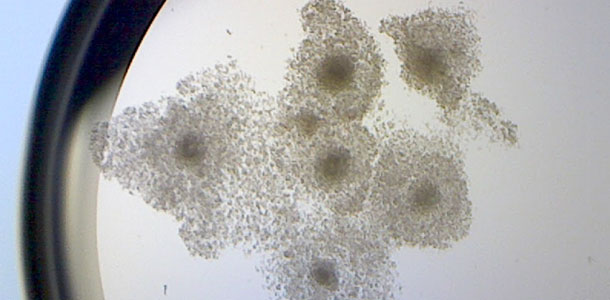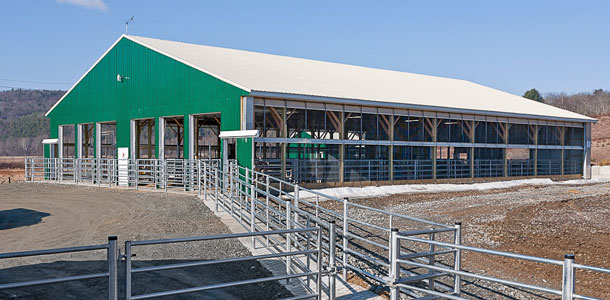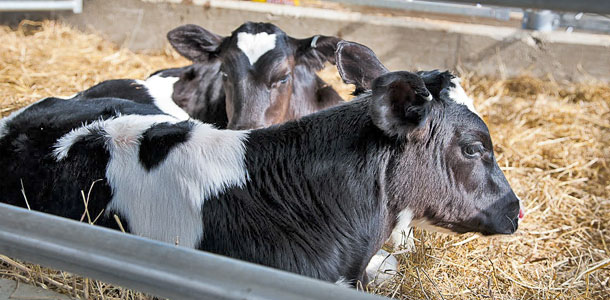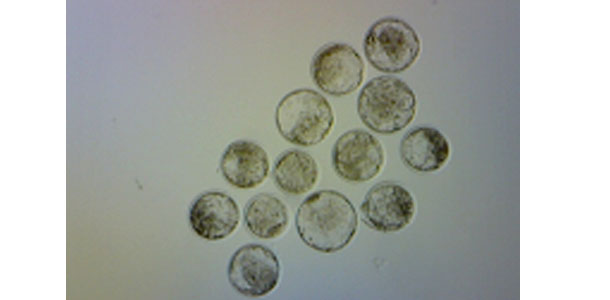Endless Mountains Veterinary Center PC (EMVC) in Rome, Pennsylvania, recognized the shift in the dairy industry from conventional embryo transfer (ET) to oocyte pick-up (OPU) and in vitro fertilization (IVF), and cracked open the books over a four-year span to research as much as possible before launching its new OPU center earlier this spring.
Though conventional embryo transfer has been around since the 1970s, the technology with OPU and IVF has recently gained ground and caught the attention of commercial dairymen for a couple of solid reasons.
“Today, the technology is such that there are good embryo development and pregnancy rates, creating an economically viable option for commercial dairymen,” says Ben Laudermilch, DVM, Endless Mountains Veterinary Center. Laudermilch, his brother, Dr. Stephen, and father, Dr. Donn, all own the veterinary facility, which caters to large and small animals. “We saw the need – or potential – to make dairies more profitable. We have invested in and are devoted to the dairy industry.
“Before now, the IVF/OPU procedure was made more for problematic cows that would not flush and would not breed. The technology today has now opened up access,” he adds.

Breaking down the abbreviations
For those who are unclear or unsure about this procedure, some basic definitions may prove helpful. Oocyte or ovum pick-up is simply a collection of eggs, removing oocytes from the ovary of the cow to permit fertilization with semen outside the body, or in vitro fertilization.
From the get-go, there are standout benefits, according to Laudermilch. With OPU and IVF, younger heifers (six to seven months old) and older donor cows can be used. With OPU and IVF versus conventional ET, you can get more calves per donor per year. You can collect from the donor every two weeks, collecting oocytes of pregnant animals in the first trimester. Additionally, you can use one unit of semen to fertilize multiple donor oocytes, cutting the cost of breeding.
“Basically, the driver for all this is to achieve faster genetic progress. It is a shortcut to improved genetic herds,” Laudermilch says.
At EMVC, the facility has a collection room for oocyte collection and an area to search for and process the oocytes. EMVC offers oocyte pickup, by aspirating follicles off the ovary, collecting oocytes, packaging them and sending them overnight to a lab called Boviteq in Madison, Wisconsin, where oocytes are fertilized to create embryos.
“The lab we use in Wisconsin has tremendously good results compared to the rest of the world,” Laudermilch says.
The lab partners with veterinary clinics, such as EMVC, that are opening their own collection centers and shipping oocytes to a centralized lab.
At the lab, oocytes are fertilized and cultured in an incubator for six to seven days; then the veterinary clinic has the option to have them shipped back to be transferred fresh, or the lab can freeze them for use at a later time or to sell.
EMVC, on average, recovers 14 oocytes per donor, but according to Laudermilch, this includes all his research cows, which pull his average down. The numbers includes dairy and beef cows.

Another unique aspect that EMVC offers is their ability to house donor cattle in their new facility. They can house up to 40 donor animals in individual boxstalls in a climate-controlled, state-of-the-art facility built in 2013, ensuring that the donor cows are as comfortable as possible. Animals are assessed daily by the clinic staff and veterinarians, and the barn features a camera security system, allowing the veterinarians to monitor the animals after normal clinic hours.
“We see OPU/IVF as a way to make U.S. dairy producers more profitable. We are trying to develop it and have partnered with the Boviteq lab to help us in that endeavor. Before, our embryo development rates were less than 10 percent. But now with the lab, we are at more than 50 percent with embryo development,” he says. Embryo development represents the percent of oocytes that develop to an embryo out of the total oocytes collected.
How the partnership works
Speaking to the EMVC and Boviteq partnership, Shantille Kruse, Ph.D., Boviteq IVF program liaison says, “Essentially, we act somewhat independently. EMVC collects oocytes from donors, and they ship to us in Madison. We perform IVF and culture, develop to embryos and ship them back.”
“The other way we function together is that we support each other in terms of marketing. We act together to promote OPU and IVF technology as a whole. We cannot have one without the other. Our company also offers tech support and consulting to veterinarians we work with,” Kruse says. “If we have trouble with a certain donor, we have veterinarians on staff that can make recommendations as to how to best manage that situation.” The lab’s current breakdown of donors is 85 percent dairy donors and 15 percent beef.
“As far as dairy donors, there is a good mix of people interested in improving genomics and increasing merit of their cows, as well as the commercial guy who wants to get more pounds of milk more efficiently,” Kruse says.
Currently, Boviteq is the largest embryo transfer company in Canada, with an ability to house 110 donors and 1,000 recipients, and it works with nine veterinary clinics in Idaho, Minnesota, Wisconsin, Illinois, Pennsylvania and Florida. Veterinarians at clinics in California, Michigan and Connecticut are expected to be trained in the next two months.

Benefits of the procedure
Overall, the OPU and IVF process for EMVC has enabled more targeted achievements, such as using elite donor animals to get all heifer calves from donor animals.
With conventional flushing done on open cattle that are not pregnant, it is performed typically every 60 days. With OPU and IVF, it can be performed every two weeks.
“You really increase the number of offspring you get through this procedure,” Laudermilch says.
Besides genetic progress capabilities, Laudermilch says commercial dairymen can benefit from this procedure’s profitability and efficiency.
“Commercial dairies are looking to become more efficient. With this genetic propagation, we are now more efficient at harnessing the potential,” he says.
“There are cows out there that make 40,000-plus pounds of milk. In Pennsylvania, the rolling herd average is 22,000 pounds. We can now harness the genetics of those more efficient cows and propagate them; that’s what we need to do,” Laudermilch adds.
Sometimes heat stress can present problems in conception with conventional methods. But Boviteq is using embryos in warmer parts of the country during heat stress.
“Though animals are less likely to conceive with A.I., you can use IVF to make a lot of embryos. We can now increase pregnancy rates during times of heat stress,” Laudermilch says.
So overall, there are increased efficiencies, faster genetic propagation and increased pregnancy rates, according to Laudermilch. This ultimately means increased profitability.
So far, commercial dairy producers and beef producers travel four hours or more to the Rome, Pennsylvania, clinic for its offerings, mostly hailing from New York and Pennsylvania.

Future developments
Where’s the technology headed? Laudermilch suggests a closer look at follicular dynamics on the ovary, as well as “how to harness each cow’s reproductive potential on an individual basis,” he says.
For people on the fence about OPU and IVF, Laudermilch notes, “A lot of people have flushed cows in the past. If a cow is worth conventional flushing, she is worth aspirating. If the producer has reason to want more offspring from her, he or she can do it more efficiently and produce more.”
Kruse also suggests the following when strongly considering OPU and IVF.
First, identify high net merit cows in the herd. “OPU/IVF works best on dairies that already have good record keeping practices in place, as well as a sound reproductive foundation with the herd. Herds that have a high return rate, for example, would not be a great candidate. They already have a good read on reproductive efficiencies,” she says.
Adds Kruse, “Expect IVF and OPU to eventually replace conventional flushing, as we are able to individualize the mating. If the donor can produce several oocytes, we could fertilize to several bulls, too.” PD
PHOTO 1: This is the laboratory equipment used for oocyte processing. Photo provided by Endless Mountains Veterinary Center.
PHOTO 2: This is an image of oocytes received at the lab. Photo provided by Boviteq.
PHOTO 3: This state-of-the-art donor facility was completed in April 2014. Each donor has their own stall, and the facility has the capability to house up to 40 donors. Photo provided by Endless Mountains Veterinary Center.
PHOTO 4: Pictured here are two calves that resulted from the IVF and OPU process. Photo provided by Endless Mountains Veterinary Center.
PHOTO 5: This is an image of the embryos produced at the lab. Photo provided by Boviteq.







